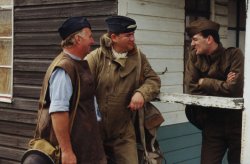Patrons:
Air Marshal Sir Ian Macfadyen
The Lieutenant Governor, His Excellency Lieutenant General Sir John Lorimer KCB DSO MBE
Off The Ground - Manx Aviation Preservation Society Museum
Jim Rawson meets the members of the Manx Aircraft Preservation Society who are opening their own museum this year.
The long term goal of one of the Island's most active historical societies will be achieved this year when the Manx Aviation Preservation Society open their own independent museum, scheduled for July 2000.
 Based in a currently disused building at the Isle of Man Airport, it will house much of the Society's growing collection of military and aviation artefacts, uniforms, information and archive photography. The group's main aim is to raise awareness of the Isle of Man's involvement in World War II.
Based in a currently disused building at the Isle of Man Airport, it will house much of the Society's growing collection of military and aviation artefacts, uniforms, information and archive photography. The group's main aim is to raise awareness of the Isle of Man's involvement in World War II.
Up until now, the basis of the museum has been confined to members' garages and spare rooms, only being exhibited at air shows and fetes during the summer months. The museum will form a single source of interest and education and will provide an opportunity to permanently display much of the group's collection.
The Society, which comprises 25 members and honorary patron Wing Commander Claire Quill, takes an interest in everything from model making to Manx military history and feels that the museum could not have come at a better time as the generation which actually lived through the war is gradually dwindling in numbers.
'This is a really important part of history which must be remembered,' said Dean Johnson, the Society's press officer. 'It's essential that we inform future generations about what their forebears sacrificed - and we're intending to do it in a fun, hands-on way. We want to be able to give children an object to hold and explain what its function was.'
Formed in 1994, the society has so far erected two plaques in memory of servicemen who died in plane crashes on the Island and some members also acted in a recent video 'The Isle of Man from the Air, dressing in WWII Manx Home Guard uniforms to illustrate their role at Jurby Airfield. The 'living history' style of education is another area that the Society want to develop. And they are hoping to organise school visits.
 'While most people are aware that the Isle of Man had a role in WWII, many do not realise the full extent of both civilian and military activity which took place', explained Dean. 'There were 40,000 naval personnel trained here, 3000 air gunners at Andreas, 7000 airmen at Jurby and they came from all over the Allied countries.'
'While most people are aware that the Isle of Man had a role in WWII, many do not realise the full extent of both civilian and military activity which took place', explained Dean. 'There were 40,000 naval personnel trained here, 3000 air gunners at Andreas, 7000 airmen at Jurby and they came from all over the Allied countries.'
'We are discovering new information all the time. For example, just a few months ago we received a photo of a group of American soldiers who had been sent for training on the Island shortly after the bombing of Pearl Harbour.'
'Although there are well known sites like the three airfields used for RAF training, there are lesser known sites all over the Island that you just wouldn't notice unless you knew what to look for. There were mock invasions staged on Douglas beach and celebrated pilots like Ginger Lacey, Peter Brothers and Pancho Villa were stationed here at times. The main thing we're trying to get across is that this history is every bit as important as the preservation of thatched cottages or burial sites.'
There have been over 300 lives lost in over 200 air crashes, not including those servicemen away from the Island, and it is from these sites that many of the artefacts have come. One of the Society's most prized possessions is an entire Spitfire engine which was excavated near Andreas. Other objects which will be on display at the museum include aircraft parts like instruments, weapons and propellors and original paperwork from the various stations on the Island.
The location of the museum is particularly relevant as the airfield itself was taken over during the war and was known as RNAS Ronaldsway. The whole of what is now Janet's Corner estate was Nissen Huts, the only surviving building from the period being the distinctive Legion Hall.
The actual museum building was lived in for a long time by an airport employee, but the three-roomed house had been given over to storage after he passed away.
Now the Society are opening their doors to the public in more ways than one - they are asking for all the help they can get in the of information, photographs and objects. One of their ongoing concerns is to transcribe the experiences of the Island's war veterans.
When the museum opens it is hoped that many local people will contribute in the form of permanent or temporary loans. Even something as trivial as an old button could be important to the Society.
In addition it's looking for sponsorship which will help get the museum up and running as soon as possible.
'We are looking for absolutely anything that might help us. Whether it's a pot of paint, a bag of nuts and bolts or a shop mannequin', said Dean. 'We need display cases, lights and some cash sponsorship to get this project off the ground.'
By kind permission of Inheritance magazine. Copyright © 2000 Inheritance magazine.
